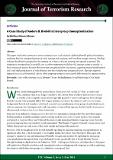Abstract
This paper undertakes summative content analytical case study of Anders Behring Breivik’s political manifesto, analysing Breivik’s conceptualisations of social ingroup and outgroup, and how these concepts interact. Findings indicate that Breivik conceptualises his ingroup on a three-level scale, ranging from specific to general. The outgroup is conceptualised as twofold, seen as either originating inside Breivik’s ingroup society or outside. A basic interaction pattern between the two group-conceptualisations was found, suggesting mutual reinforcement and a self-replicating pattern of radicalization and entrenched group-conceptualisation. Ingroup categories appeared to exist as hierarchical subsets, while outgroup categories were clearly differentiated as separate entities.
Citation
Holmen Johnsen, M. (2014). A Case Study of Anders B. Breivik’s Intergroup Conceptualisation. Journal Of Terrorism Research, 5(2), pp. 1-11.
Publication
Journal of Terrorism Research
Rights
This is an open access article published in Journal of Terrorism Research. This work is licensed under a Creative Commons Attribution 3.0 License (http://creativecommons.org/licenses/by/3.0/)
http://creativecommons.org/licenses/by/3.0/


